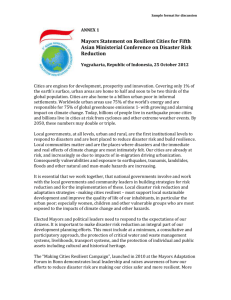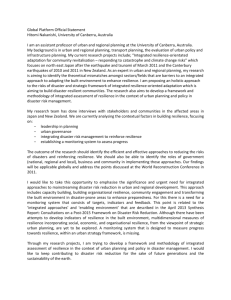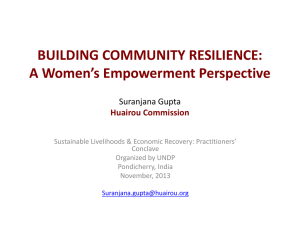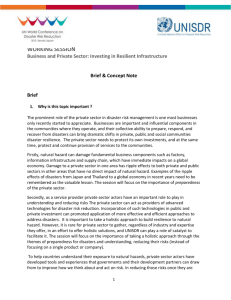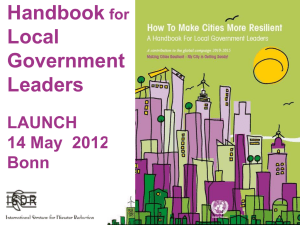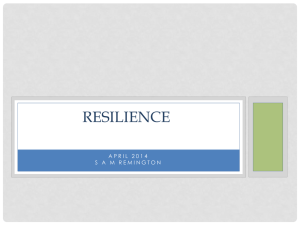Top Leaders Forum 2013
advertisement
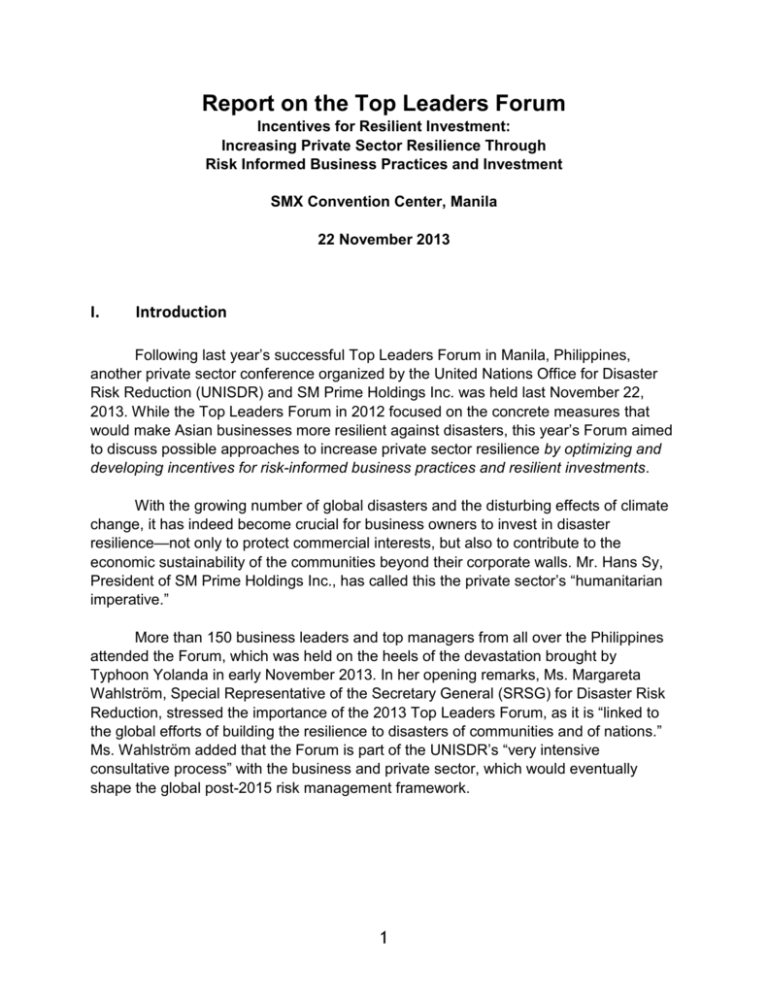
Report on the Top Leaders Forum Incentives for Resilient Investment: Increasing Private Sector Resilience Through Risk Informed Business Practices and Investment SMX Convention Center, Manila 22 November 2013 I. Introduction Following last year’s successful Top Leaders Forum in Manila, Philippines, another private sector conference organized by the United Nations Office for Disaster Risk Reduction (UNISDR) and SM Prime Holdings Inc. was held last November 22, 2013. While the Top Leaders Forum in 2012 focused on the concrete measures that would make Asian businesses more resilient against disasters, this year’s Forum aimed to discuss possible approaches to increase private sector resilience by optimizing and developing incentives for risk-informed business practices and resilient investments. With the growing number of global disasters and the disturbing effects of climate change, it has indeed become crucial for business owners to invest in disaster resilience—not only to protect commercial interests, but also to contribute to the economic sustainability of the communities beyond their corporate walls. Mr. Hans Sy, President of SM Prime Holdings Inc., has called this the private sector’s “humanitarian imperative.” More than 150 business leaders and top managers from all over the Philippines attended the Forum, which was held on the heels of the devastation brought by Typhoon Yolanda in early November 2013. In her opening remarks, Ms. Margareta Wahlström, Special Representative of the Secretary General (SRSG) for Disaster Risk Reduction, stressed the importance of the 2013 Top Leaders Forum, as it is “linked to the global efforts of building the resilience to disasters of communities and of nations.” Ms. Wahlström added that the Forum is part of the UNISDR’s “very intensive consultative process” with the business and private sector, which would eventually shape the global post-2015 risk management framework. 1 II. Purpose of the Forum Similar in structure to last year’s private conference, the 2013 Top Leaders Forum was divided into two main parts. The morning session, attended by UNISDR representatives and top business leaders from all over the country and the region, explored the need to identify and develop incentives with immediate financial benefits to directly stimulate resilient investment. After a series of talks from event host Mr. Hans Sy (President, SM Prime Holdings), Ms. Margareta Wahlström (Special Representative of the Secretary General for Disaster Risk Reduction), Ms. Sandra Wu Wen-Hsiu (Chairperson and CEO, Kokusai Kogyu Holdings), Mr. Gene Alfred Morales (Executive Director, PricewaterhouseCoopers Financial Advisors, Inc.), Mr. Richard Sanders (Senior Catastrophe Risk Analyst, Willis Group), Mr. Kevin Snowdon (Executive Director, Willis Group), and Mr. Karthik Subburaman (Country Manager, ECCI Philippines), a round-table discussion among the top business leaders ensued. With the recent destruction brought by Typhoon Yolanda in different parts of the country as the frame of reference, Mr. Jerry Velasquez, UNISDR Head of Advocacy and Research, posed the following questions to serve as the springboard for the round-table discussion: 1) In the context of the recovery, reconstruction and long-term development of the affected areas, what metrics and standards would you take when you do your business in these areas and what would you like to promote when you partner with the government? 2) What would be the rating for the structures that you would be building or rebuilding? Are you going to be adhering to the existing building code? Or would you be building above code? If yes, how much above code? 3) How can you share the practices that you intend to do? 4) How can we step up to the challenge of building resilience in the face of this typhoon? The afternoon session, on the other hand, entailed the participation of business managers from different companies in the Philippines. Following the messages from Ms. Annie Garcia (President, SM Supermalls), Ms. Wahlström, and Senator Loren Legarda (Chair of the Senate Committee on Environment), the afternoon participants were asked to form three big groups that would each tackle the following topics: metrics and standards, resilient building rating systems, and sustainability reporting. The managers were tasked to discuss and offer practical solutions to the following questions: 1) For metrics and standards: What are existing metrics and benchmarking tools for business resilience? What standards already exist? 2 2) For the rating systems for resilient buildings: How do we develop a resilient building rating system? Which entity should issue this system? 3) For the potential of sustainability reporting: How can we promote sustainability reporting by companies? In what ways can corporate risk and resilience be incorporated in this? III. Highlights of the Speeches (Morning Session) Mr. Hans Sy, SM Prime Holdings, Inc. Mr. Sy is the President of SM Prime Holdings, the Philippines’ largest mall operator. SM Prime fully operates 47 malls in the Philippines. In collaboration with UNISDR, SM Prime organized and hosted the 2012 and 2013 Top Leaders Forums in Manila. In his welcome remarks, Mr. Sy described the disaster response and disaster preparedness through resilient investment in Asia and in developing countries such as the Philippines as a “continuous challenge.” Stressing that the total cost of typhoonrelated destruction in the country since 2002 has amounted to more than P10 billion, Mr. Sy said that there is indeed a need to discuss possible incentives for business investments in resilience. He also mentioned that Metro Manila businesses had not been as affected compared to the other local communities because of “our heavy investment in disaster resilience to ensure the longevity of our establishments and safeguarding the communities wherein we operate.” Mr. Sy, who presented his business case at the UNISDR 4th Global Platform in Geneva, Switzerland earlier this year, said he had witnessed the commitment and undertakings of both the public and private sectors across the globe to contribute to the global risk reduction dialogue toward positive change. He pointed out that the impact of disaster has become a growing concern, not only in developing countries like the Philippines, but all throughout the world. He concluded that collective inputs and participation from the Forum members would help shape future policies and disaster risk reduction. 3 Ms. Margareta Wahlström, Special Representative of the Secretary General (SRSG) for Disaster Risk Reduction Ms. Wahlström was appointed as United Nations Secretary-General Ban Kimoon’s first Special Representative for Disaster Risk Reduction in November 2008. She is also head of the UNISDR, the focal point in the United Nations system for the coordination of disaster reduction. Under the SRSG’s leadership, UNISDR is in charge of supporting the implementation of the “Hyogo Framework for Action 2005-2015: Building the Resilience of Nations and Communities to Disasters” throughout the world and facilitating the process of developing a post-2015 framework for disaster risk reduction. In her opening message, Ms. Wahlström stressed the importance of the 2013 Top Leaders Forum, explaining its linkage to the current global efforts of building resilience to disasters of communities and of nations “as it says in our leading framework at the Hyogo Framework for Action.” She added that the business and private sector play a very significant role in the creation of the UN’s post-2015 risk management framework. Ms. Wahlström pointed out: “Business and private sector represents a very large portion of investments in literally all countries in the world. No country, no government, no civil society on its own will be able to manage, reduce risks and strengthen resilience; it takes the engagement by business and private sector.” She recalled how the private sector’s voice was virtually nonexistent in the 2005 world conference on disaster risk reduction. “We aim to see that change radically for 2015, and we’re working hard to make sure that business puts its foot forward and say: we are a part of this, this is what we need, this is what we intend to contribute, this is how we intend to act in order to contribute to that collective effort,” she added. Ms. Sandra Wu Wen-Hsiu, Kokusai Kogyo Holdings Co., Ltd. Ms. Wen-Hsiu is Chairperson and CEO of Kokusai Kogyo Holdings Co., Ltd. She serves as Chair of the UNISDR Private Sector Advisory Group (PSAG). In her speech, Ms. Wen-Hsiu gave an overview of UNISDR’s work with the private sector. She related how the private sector was a “hot topic” at the recent global platform and in the Global Assessment Report (GAR) in 2013. Ms. Wen-Hsiu enjoined the business leaders to join the PSAG’s five working groups: the first working group focuses on working with local governments; the second on working on a system to help the private sector develop a resilience benchmarking system for businesses; the third on reaching out at the global level through organizations such as the World Economic Forum and the UN Global Compact; the fourth on crafting the private sector input to the 4 post-2015 Hyogo Framework for Action; and the fifth working group on getting more private sector support for UNISDR, building up membership and membership benefits. Ms. Wen-Hsiu said the private sector needed to play a strong role at the regional level, such as the Asian Ministerial Conference to be held in Bangkok, Thailand in June 2014, and the global level, particularly the UN World Conference for the Disaster Risk Reduction in Sendai, Japan in March 2015. Mr. Aris Papadopoulos, Titan America Mr. Papadopoulos is CEO of Titan America and a member of the UNISDR PSAG. He served as the Advisory Group’s first Chair from 2011 to 2013. In a video message, Mr. Papadopoulos defined resilient investment as investment that can withstand the increase in future hazards, and is capable of quickly rebounding whenever such events occur. Resilient investment is both sustainable and responsible while non-resilience is unsustainable and irresponsible, he added. Mr. Papadopoulos emphasized the need to work to create and enforce stronger building codes, as the current ones rarely address present or future hazards. He stressed: “The point is that investing resiliently, which often means investing above code, needs to become the new norm, rather than just the exception. That is the true meaning of resilient investment.” He added that the challenge to private and public collaboration is to create conditions that encourage all investments from the private dwellings to large infrastructure to be done resiliently—conditions that could include policies, incentives (e.g. tax incentives), removal of barriers, and communication of risks. He further urged the private sector to engage in a dialogue with the public sector to examine the conditions and incentives that could work to motivate investments to go above code. Mr. Gene Alfred Morales, PricewaterhouseCoopers (PwC) Financial Advisors, Inc. Mr. Morales is Executive Director of PricewaterhouseCoopers Financial Advisors, Inc., a multinational professional services firm based in London, United Kingdom. In his presentation on metrics and standards, Mr. Morales mentioned the present challenge to leverage on private sector capabilities amid a “new environment of uncertainty.” He emphasized, “When disaster strikes, the leaders of an organization caught unaware or unprepared may find themselves with no company or organization to manage at all.” 5 He said that in response to this challenge, the UNISDR and PwC have been working together since 2012 to develop collaborative initiatives and frameworks for public-private sector action on building resilience. Mr. Morales said that they have completed Phase 1 of the collaborative work, forming an initial “disaster risk community” comprised of 14 leading global companies. The PwC and the UNISDR conducted workshops with these companies, using the Disaster Risk Management Framework that the two organizations developed. The said framework, according to PwC, involves three important elements: 1) UNDERSTAND the impact (of disasters) and potential threats to companies; 2) RESPOND by choosing appropriate actions on how to deal with the risk (e.g. natural hazards); and 3) consider the ENABLING ENVIRONMENT’s external forces (i.e. government regulations and policies) and internal forces (i.e. capability and skills of people within the organization). Mr. Morales said the UNISDR and PwC have since started moving to Phase 2 of their collaborative work, aiming at transforming the way sectors and industries approach the disaster risk management process by providing concrete actions and practical guidelines. Mr. Richard Sanders, Willis Group Mr. Sanders is a Senior Catastrophe Risk Analyst of the Willis Group, a global insurance brokerage company heavily involved in resilience. In his presentation, Mr. Sanders focused on applying science to learning more about and better understanding natural disasters. He explained that the Willis Group is part of the scientific community through the Willis Research Network—working with global academia to find the “appropriate science” and applying it to the needs of the insurance industry. He said that among the key parts of the work available from science are the following global models: global flood model, tropical cyclone laboratory, global landslide model, and the annual clustering of typhoons model. These models, according to Mr. Sanders, help assess natural catastrophe vulnerability and risk “in areas worldwide where otherwise we would have no way of understanding vulnerability and risk.” 6 Mr. Kevin Snowden, Willis Group Mr. Snowden is Executive Director of the Willis Group. He leads a team of risk engineers within the Willis Group to be able to assess resilience on the ground and catalyze ideas on how private sector, governments and local governments can use these to assess their own resilience. While his colleague concentrated on the application of science vis-a-vis resilience against natural disasters, Mr. Snowden focused on the engineering aspect of the issue. He shared that one of the only ways to get a true indication of resilience “is to have a risk engineer visit and assess the buildings and structures on the field.” He added that resilience is a multi-discipline, multi-functional approach classified into four areas: 1) building and construction; 2) protection and control of the building and early alarm systems; 3) building operations and maintenance; and 4) recovery mechanisms in place to be able to recover quickly. Underpinning all these areas, according to Mr. Snowden, is an effective audit and monitoring program. Mr. Karthik Subburaman, ECCI Philippines Mr. Subburaman is the Country Manager of ECCI Philippines, a process improvement solutions provider focused on process consulting, automation solutions, and learning outsourcing activities. Mr. Subburaman pointed out in his presentation that while reporting has advanced in the last 10 years, the topic of disclosing information on disaster risk reduction or disaster risk management “has not been at the fore when it comes to reporting itself.” He further defined sustainability reporting as the practice of measuring, disclosing and being accountable to internal and external stakeholders for organizational performance toward the goal of sustainable development. Mr. Subburaman stressed that the most important thing to do in sustainability reporting is to make sure that it is balanced—highlighting both the positives and the negatives—and material, only reporting the aspects that will impact the organization’s performance. He said that among the trends in sustainable reporting include the continued increase in the number of companies that engage in the activity: from 30 companies two decades ago, 5,000 companies now do sustainable reporting. 7 IV. The Round-table Discussion: Main Issues Mr. Jerry Velasquez, UNISDR Head of Advocacy and Research, opened the round-table discussion by stressing the importance of building above code and understanding both present and future risks. He then posed the following questions to serve as the springboard for the round-table discussion: 1) In the context of the recovery, reconstruction and long-term development of the affected areas, what metrics and standards would you take when you do your business in these areas and what would you like to promote when you partner with the government? 2) What would be the rating for the structures that you would be building or rebuilding? Are you going to be adhering to the existing building code? Or would you be building above code? If yes, how much above code? 3) How can you share the practices that you intend to do? 4) How can we step up to the challenge of building resilience in the face of this typhoon? The following are the main issues raised during the discussion. Resilience amid recent disasters As expected, Typhoon Yolanda—which ravaged the country only two weeks before the Top Leaders Forum—served as the fulcrum of the entire discussion. Many of the business leaders present at the Forum acknowledged the unexpected strength of the typhoon and how it hurt their respective companies. Mr. Ernest Cu, President and CEO of Globe Telecom, recounted how Typhoon Yolanda destroyed over 80 of their towers despite the fact that they built above code. Ms. Rosemarie Rafael, President of Airspeed International Corporation agreed, stressing that “nobody had the time to prepare for such a typhoon.” Mr. Cu then shared the massive restorative work and preparations Globe Telecom is undergoing post-Yolanda: considering the more expensive undergroundtype of infrastructure, preparing their teams in a much better fashion, and increasing their amount of transport. Ms. Olive Ramos, President and CEO of Tiger Airways, pointed out that it was now necessary for companies to “over prepare” in light of the worsening disasters taking place in the country and worldwide. Mr. Velasquez pointed out that Business Continuity Planning was the topic of the 2012 Top Leaders Forum. He also emphasized that if super typhoons and other serious 8 disasters are becoming the “new normal,” then companies and businesses should make the necessary adjustments. Helping the affected communities Most of the participants shared how they did their part in helping the typhoonravaged communities where their businesses operate. Ms. Rafael of Airspeed said that as her company got involved in relief operations, bringing all types of transportation and logistics to the affected areas. Ms. Olive Ramos, President and CEO of Tiger Airways, said that their airline company gave free flights (or “mercy flights”) to victims and evacuees. Aside from the immediate relief efforts, some business leaders also expressed willingness to participate in the recovery of the affected communities. Ms. Alexandra Prieto-Romualdez, President and CEO of the Philippine Daily Inquirer, pointed out the need for a possible “master plan” for a more coordinated effort among members of the private sector. In response, PSAG Chair Ms. Wen-Hsiu emphasized the need to create awareness of how the private sector should work together to make cities and communities resilient, “as not one company can provide a solution to all problems, even to one problem.” Risk sharing between the public and private sector There was a general agreement among the participants that both the government and private sector should work together toward the goal of achieving resilience against disasters. According to Ms. Wen-Hsiu, the local governments in Japan work closely with the private sector and engage the local companies in preparation for possible crises. The government organizes and coordinates the different industries to ensure that they work together harmoniously. Mr. Delfin Wenceslao, Director of Alphaland Corp. and the Philippine Contractors Association, said the association had experienced firsthand how difficult it is to pursue emergency response, recovery and resilience building after Typhoon Yolanda struck. He said that while members of the association immediately mobilized their workers and equipment to help in the clearing of road debris, they encountered difficulty in accessing areas “where politics is very strong.” He proposed a law that in times of crises and disasters, the government and private sector should automatically step in—with the private sector taking the lead should government fail to do so. “Planning and investment should come from the private sector, but support should come from the government,” Mr. Wenceslao said. 9 Mr. Hans Sy, on the other hand, stressed that the private sector should begin “stepping up,” especially because government bureaucracy may impede efforts to pursue resiliency against worsening disasters. “I don’t want to blame the government, neither do I want to rely on it. The private sector should be able to step up much faster,” Mr. Sy said, adding the SM Group of Companies would continue to lead the local private sector toward corporate social responsibility and resilience. Building above code Mr. Sy emphasized the importance of building above code, saying that businesses owe it to their consumers and the general public to do so. He also mentioned how he was inspired to build one of his malls, the SM Mall of Asia, three meters in excess of what was required by the building code because of possible adverse effects of climate change on the sea level. He also patterned the Mall of Asia Arena after a similar building that was left standing even after Hurricane Katrina pounded New Orleans some years back. He said of his resilient buildings: “I don’t think I would do it just right, I’ll do it 50 percent more.” Incentives for resilience building With regards to possible incentives for resilience building, Ms. Olive Ramos of Tiger Airways spoke in behalf of the other participants who expressed concerns about the extra costs that disaster preparation may entail. She said that if one industry spends a lot of money to prepare for disaster response and resilience building, a partner industry (e.g. the insurance industry or a supplier) should help. For example, the insurance industry could bring down the premiums of a particular company that invests in resilience. “We should help each other because if a business is not profitable, then it’s not sustainable. We have to be sustainable in order for us to help rebuild our communities,” Ramos said. Mr. Velasquez of UNISDR acknowledged this concern, saying that there are indeed no incentives from insurance to promote investments in resilience. He suggested that the acceptance and adoption of new building standards might help bring down insurance premiums. SMEs and resilience Some of the business leaders expressed concern that SMEs (Small and Medium Entrepreneurs) or small businesses may not have the budget for resiliency building, unlike big companies. Ms. Rafael of Airspeed International Corporation asked how 10 these smaller companies could participate in the “resiliency project,” considering their limited resources. Bert van Walbeek of the Pacific Asian Travel Association (PATA) echoed this sentiment, pointing out that while big companies are “already converted” to the idea that resiliency is important to businesses, SMEs may have different concerns. “What can we do for the SMEs? How do we help them rebuild? Those are the questions that we should ask ourselves,” van Walbeek said. Sustainability reporting Mr. Cu of Globe Telecom said that his company has been at the forefront of sustainability reporting and has been cited and recognized by some organizations for the type of reporting that it does. Tied to reporting is the sharing of good practices that would create awareness about the importance of resilience building. Mr. Sy and Ms. Wen-Hsiu, both members of the Private Sector Advisory Group or PSAG, emphasized the need to share awareness to further promote the important role businesses could play in making communities all over the country resilient to disasters and calamities. Summing up Ms. Wahlström summarized the insights that emerged during the discussion: • • • • The participants picked up on a few extremely critical issues such as the sharing of risks, and that the real solution to the problem of worsening disasters lie in genuine resilience investments and taking a wider responsibility for risks. Members of the private sector discussing ideas with one another is much more effective than bureaucrats speaking to members of the business industry. The PSAG, according to Ms. Wahlström, remains the most powerful instrument to reach out to business with regards to gathering ideas and spreading awareness about key advocacies such as disaster resilience. While SMEs are acknowledged to be neophytes in the resiliency business, there are also a lot of bigger companies that still don’t see disasters “as major risks among other risks,” Ms. Wahlström pointed out. Even if the public sector is responsible for a country’s regulatory environment, there are many countries in the world wherein the governments have not yet really been driving the idea of resilience. There is a big opportunity for the private sector “to really be that driver.” 11 Ms. Wahlström said that the UNISDR team would be guiding the Philippine private sector in “making their implicit proposals during the discussion more explicit” in the next 12 months and help ensure that the opportunity created during the Top Leaders Forum would yield positive results. V. Other Important Events UNISDR Video Message A special video message from the UNISDR was shown during the Top Leaders Forum morning session. The video focused on the UNISDR’s message that resilience is vital in an interconnected world, wherein disaster in one place sends economic shockwaves around the globe. Recognition of Mr. Hans Sy’s Efforts After the round-table discussion, Ms. Wahlström and Ms. Wen-Hsiu awarded a plaque of appreciation to Mr. Hans Sy for his continuing partnership with the UNISDR, his vital role in the PSAG, and his tireless efforts in spearheading private sector initiatives in the country toward disaster risk reduction and resilience. VI. Highlights of the Speeches (Afternoon Session) Ms. Annie Garcia, SM Supermalls Ms. Garcia is the President of SM Supermalls, which operates 47 malls in the country and receives about 3.8 million people every day. Ms. Garcia said in her welcome remarks that SM’s efforts in the realm of disaster resilience and response is grounded in pursuing not only “the best interest of the business, but also the best interests of the communities, the employees, its business partners, and shareholders.” She stressed the need to identify and develop incentives that have an immediate financial benefit to directly stimulate resilient investment. “This will matter a lot in recognizing the efforts of the private sector,” she said. 12 Ms. Margareta Wahlström, Special Representative of the Secretary General (SRSG) for Disaster Risk Reduction In her opening message, Ms. Wahlström shared the morning session’s roundtable discussion highlights with the afternoon participants, particularly how the private sector can use the Typhoon Yolanda crisis as a test for its own aspirations in both making their businesses viable and demonstrating concern for the communities in which they operate. She then said that the aim of the afternoon session would be to hold more practical discussions on the issue of resilience “in support of the top leaders’ commitment to continue this work.” Senator Loren Legarda, Chair of the Senate Committee on Environment Since her first term in the Philippine Senate in 1998, Sen. Legarda’s advocacy has been to protect the environment, adapt to climate change and mitigate its impacts. She has consistently been calling of stronger support for disaster risk reduction and resilience in the country. Sen. Legarda emphasized a key message in her speech: “We do not build resilience through relief efforts. Instead, we have to lessen the need for disaster relief. Disaster risk reduction and climate change adaptation must be closely linked to development. The business sector, which drives the engine of growth, has a role in making that happen.” She shared that advocating for climate change in the country has never been easy. “It was an abstract term for many, until disasters, in massive scale, started to happen. Now, people are listening.” Sen. Legarda revealed that the Senate is currently deliberating on the 2014 government budget. Under the National Expenditure Program, approximately P48 billion is allocated for disaster risk and mitigation programs of various agencies of the government. However, she stressed that while a vital component of building the country’s resilience is a climate-sensitive and disaster risk reduction-proofed budget, “the heightened engagement of the business sector in disaster risk reduction (DRR) is crucial as well in preventing substantial business losses and economic development setbacks resulting from disasters of unprecedented scale.” 13 “As disaster risk reduction is everybody’s business, a more visible action from the business community is required. It is not enough that businesses come up with continuity plans that will show how prepared they are and how they can swiftly spring back to operations after each disaster. Businesses need to make plans with the general population in mind. A massively decimated market will not allow businesses to thrive. It is therefore in the private sector’s best interest to strengthen its support to climate action and DRR initiatives,” Sen. Legarda stressed. She said that the private sector should: 1) support adaptation measures that help build assets and strengthen the resilience of communities, and 2) help finance mitigation activities and buttress adaptation measures. Sen. Legarda said that as an elected representative and partner in the pursuit of national goal, she would listen to the private sector’s voice and proposed relevant recommendations. “This means considering possible policy reforms not only in strengthening your resilience as a community, but further to promoting incentives for resilience investment.” VII. Focused Group Discussion: Overview Ms. Kiki Rebecca Lawal of the UNISDR provided an overview of the ensuing focused group discussions. The afternoon participants were asked to form three big groups that would each tackle the following topics: metrics and standards, resilient building rating systems, and sustainability reporting. The managers were tasked to discuss and offer practical solutions to the following questions: 1) For metrics and standards: What are existing metrics and benchmarking tools for business resilience? What standards already exist? 2) For the rating systems for resilient buildings: How do we develop a resilient building rating system? Which entity should issue this system? 3) For the potential of sustainability reporting: How can we promote sustainability reporting by companies? In what ways can corporate risk and resilience be incorporated in this? VIII. Presentation of Action Points Metrics and Standards Mr. Joel Belardo of BDO Insurance served as the moderator of the group on metrics and standards. In presenting the action points, he said that the group members 14 unanimously agreed that they would use all available information from both government and private sector to provide the mapping of exposures whenever they would do business. He also said that the group members proposed to emulate present good practices on building standards (e.g. installation of flood barriers, retrofitting buildings, making foundations stronger), and to continue creating awareness on the importance of these standards. Rating System for Resilient Building Mr. Richard Sanders of Willis shared the suggestions of the group tasked to discuss the rating system for resilient building. The members stressed the importance of resilience “incentivization,” based on the methods of the life insurance industry. They also suggested lowering the insurance premium rates and property taxes, and improving insurance penetration and education in the country to make people understand its importance. As to the issue of policing resilient building, the group members suggested that a private organization—such as an insurance association—could do it. Potential of Sustainability Reporting Mr. Karthik Subburaman of ECCI discussed the action points of the third and final group. The group on sustainability reporting came up with the following insights: 1) There should be senior management trust to ensure the continuous commitment to conduct sustainability reporting; 2) There should be a budget/allocation of resources for sustainability reporting; 3) Benchmarks such as GRI should be made more familiar and available; and 4) There is difficulty and confusion in implementing sustainability reporting because of a lack of familiarity with existing benchmarks. Summing Up Mr. Jerry Velasquez summarized the insights that emerged during the focused group discussions: 15 Metrics and Standards • • The group on metrics and standards looked at the issue of metrics and standards from a very practical point of view: proposing to understand existing and ongoing practices because they are far easier to replicate. There are a lot of things that have been done and could still be done on understanding hazards, looking at exposure and reducing vulnerability, and increasing awareness and preparedness. Rating System for Resilient Building • • The group examined the question of rating system for resilient building from the point of view of life insurance: considering the kind of vulnerabilities a structure has, looking at both incentives and disincentives, and asking the question of “who pays” (Does the business pay? Does the government pay? Does the electric company pay? Is it subsidized? Should insurance premiums be reduced?) Mr. Velasquez suggested that businesses should clarify who they are saving by investing in resilience, so it would be clear who should pay. “If it is the investment, then those that invested should be paid,” he said. Potential of Sustainability Reporting • • IX. The group’s action points revolved around these two questions: “Why do we have to report?” and “What is the incentive?” Mr. Velasquez pointed out that the requirements outlined by the group members (e.g. senior management trust, budget) are similar to the requirements of other standards (e.g., ISO). He posed this question for the group to reflect on: “Why should you do ISO 1000, for example, and not resiliency reporting? What is the incentive for ISO?” Conclusion Mr. Jerry Velasquez of the UNISDR closed the afternoon’s focused group discussion by proposing that interested participants could coordinate with the UNISDR and the SM Prime team to promote their good practices on resilience with the rest of the industry. He said that UNISDR and the Philippine private sector could continue the exchange of information, identify the “shareable” practices, and provide an incentive to the private sector by promoting their good practices globally. “That way it helps your peers, then we help by promoting you,” he added. 16 In their closing remarks, both Ms. Sandra Wu and Ms. Margareta Wahlström praised the enthusiasm and commitment the participants showed in the event, adding that the Philippine private sector should take up Sen. Loren Legarda’s offer to champion the disaster resilience cause and make it a reality in the country. Ms. Wahlström concluded that the UNISDR would continue working with the Philippine private sector, inviting the participants’ feedback from the Top Leaders Forum—including ideas on how to take the proposals forward and other suggestions regarding future activities and collaborations. 17



